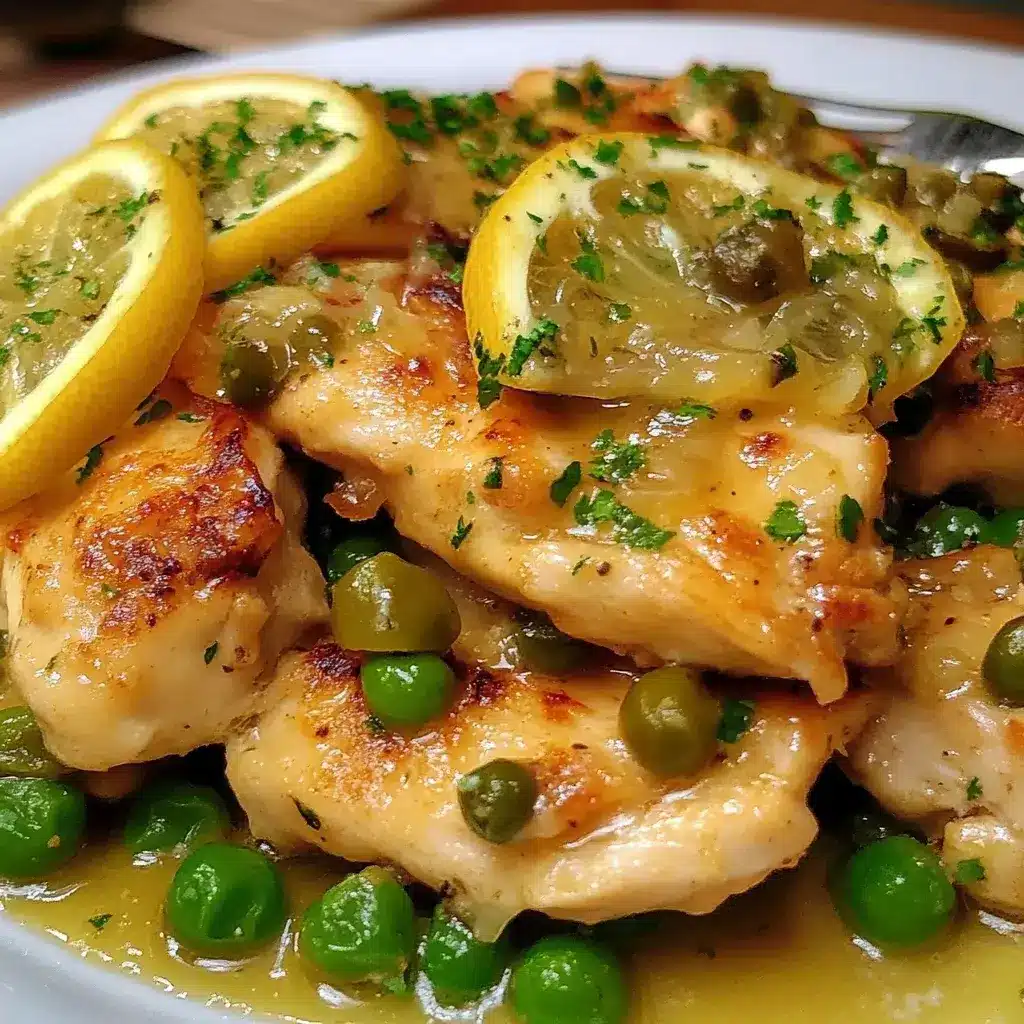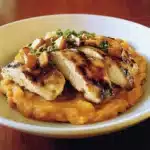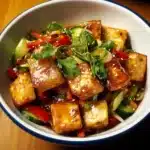The first time I whipped up this Quick Lemon Chicken and Peas, it was one of those chaotic Tuesday evenings. You know the drill: homework battles, looming deadlines, and that sinking feeling that dinner was still a figment of my imagination. I needed something fast, something that wouldn’t require a mountain of dishes, and frankly, something everyone in my picky family would actually eat without protest. Skeptical but desperate, I turned to this recipe. The results? Astonishing. The chicken was unbelievably tender, bursting with a bright, zesty lemon flavor that wasn’t overpowering, just perfectly balanced. The peas added a lovely sweetness and a pop of color, making the dish look as good as it tasted. My kids, who usually turn their noses up at anything green, actually asked for seconds of the “lemony chicken with the little green balls!” My partner, a man of few words when it comes to food compliments, simply said, “This is a keeper.” And it truly has been. It’s become our go-to for a delicious, healthy, and incredibly speedy weeknight meal that feels a little bit special without any of the fuss.
Why This Quick Lemon Chicken and Peas Recipe Will Become Your Go-To
In a world where time is a precious commodity and the demand for healthy, delicious meals is ever-present, finding a recipe that ticks all the boxes can feel like striking gold. This Quick Lemon Chicken and Peas recipe is precisely that – a culinary gem. It’s more than just a meal; it’s a solution for busy weeknights, a delight for the taste buds, and a surprisingly elegant dish that’s simple enough for novice cooks yet satisfying for seasoned foodies.
One of the primary draws of this dish is its speed and efficiency. In under 30 minutes, you can transform a few humble ingredients into a vibrant, flavorful main course. This makes it an absolute lifesaver on those evenings when you’re tempted by takeout but crave something homemade and wholesome. The minimal prep work involved means less time chopping and more time enjoying your evening.
Beyond its convenience, the flavor profile is truly exceptional. The star of the show, fresh lemon, imparts a bright, zesty tang that cuts through the richness of the chicken and beautifully complements the sweetness of the peas. It’s a refreshing change from heavier, cream-based sauces. The garlic adds a pungent depth, while a touch of chicken broth creates a light, savory sauce that coats every piece of chicken and every pea. This isn’t just “lemon chicken”; it’s a nuanced dance of flavors that feels both comforting and invigorating.
Health-consciousness is another significant advantage. Lean chicken breast provides high-quality protein, essential for muscle repair and satiety. Peas contribute fiber, vitamins, and a surprising amount of plant-based protein. By using olive oil, a heart-healthy fat, and relying on fresh ingredients rather than processed ones, you’re serving up a meal that nourishes the body as well as it pleases the palate. It’s naturally low in carbohydrates and can easily be adapted for various dietary needs.
The versatility of this recipe also adds to its appeal. While delicious on its own, it pairs beautifully with a wide array of side dishes. Serve it over fluffy quinoa, brown rice, or couscous to soak up the delicious lemony sauce. A side of roasted asparagus or a simple green salad would round it out perfectly. You can even shred the leftover chicken for a fantastic sandwich or salad topping the next day.
Finally, this Quick Lemon Chicken and Peas recipe is incredibly family-friendly. The flavors are bright but not overpowering, making it palatable for even the pickiest eaters. Kids often enjoy the combination of tender chicken and sweet peas, and the vibrant colors make it visually appealing. It’s a fantastic way to get a healthy dose of protein and vegetables onto the family dinner table without any fuss. It’s a testament to the idea that simple, fresh ingredients, when combined thoughtfully, can create something truly special.
Ingredients
Here’s what you’ll need to create this delightful dish:
- 1.5 lbs Boneless, Skinless Chicken Breasts: Cut into 1-inch cubes. This ensures quick and even cooking.
- 2 Tablespoons Olive Oil: Extra virgin is preferred for its flavor and health benefits.
- 3 Cloves Garlic: Minced. Fresh garlic provides the best aromatic punch.
- 1/2 Cup Chicken Broth: Low-sodium is a good choice to control the saltiness.
- 1/4 Cup Fresh Lemon Juice: Approximately 1-2 lemons, depending on size. Freshly squeezed makes all the difference!
- 1 Teaspoon Lemon Zest: Adds an intense, bright lemon aroma and flavor without extra tartness.
- 1 Cup Frozen Peas: No need to thaw; they cook quickly and retain their vibrant color.
- 2 Tablespoons Fresh Parsley: Chopped. For garnish and a touch of fresh, herbaceous flavor.
- Salt and Freshly Ground Black Pepper: To taste. Seasoning is key!
- Optional: 1 Tablespoon All-Purpose Flour or Cornstarch (mixed with 1 tbsp cold water for a slurry): If you prefer a slightly thicker sauce.
Instructions
Follow these simple steps for a perfect Quick Lemon Chicken and Peas every time:
- Prepare the Chicken: Pat the cubed chicken breasts dry with paper towels. Season generously with salt and freshly ground black pepper. This helps create a nice sear and builds flavor from the start.
- Sear the Chicken: Heat the olive oil in a large skillet or Dutch oven over medium-high heat. Once the oil is shimmering (but not smoking), add the chicken cubes in a single layer. Avoid overcrowding the pan; cook in batches if necessary. Cook for 3-4 minutes per side, until nicely browned and cooked through. The internal temperature should reach 165°F (74°C). Remove the chicken from the skillet and set it aside on a plate.
- Sauté Aromatics: Reduce the heat to medium. Add the minced garlic to the same skillet and sauté for about 30-60 seconds, until fragrant. Be careful not to burn the garlic, as it can become bitter.
- Deglaze and Build Sauce: Pour in the chicken broth, scraping up any browned bits (fond) from the bottom of the pan with a wooden spoon. These bits are packed with flavor! Bring the broth to a gentle simmer.
- Add Lemon and Thicken (Optional): Stir in the fresh lemon juice and lemon zest. If you prefer a thicker sauce, now is the time to whisk in the flour (sprinkle it over and whisk quickly to avoid clumps) or the cornstarch slurry. Let the sauce simmer for 1-2 minutes, allowing it to thicken slightly.
- Return Chicken and Add Peas: Return the cooked chicken (and any accumulated juices from the plate) to the skillet. Add the frozen peas. Stir everything together to coat with the sauce.
- Simmer and Finish: Cook for another 2-3 minutes, or until the peas are heated through and tender-crisp, and the chicken is fully reheated. The sauce should be nicely combined.
- Garnish and Serve: Remove the skillet from the heat. Stir in the chopped fresh parsley. Taste and adjust seasoning with more salt, pepper, or a tiny squeeze of lemon juice if needed. Serve immediately.
Nutrition Facts
- Servings: 4
- Calories per serving: Approximately 350-400 kcal (This can vary based on the exact size of chicken breasts and amount of oil used.)
- Protein: High (around 45-50g). Excellent source of lean protein for muscle building and satiety.
- Fat: Moderate (around 15-18g). Primarily from olive oil, which contains healthy monounsaturated fats.
- Carbohydrates: Low (around 8-10g). Mostly from the peas, providing some fiber and natural sugars.
- Vitamin C: Significant. Thanks to the fresh lemon juice and peas, contributing to immune support.
Preparation Time
- Total Time: Approximately 20-25 minutes
- Prep Time: 10 minutes (cutting chicken, mincing garlic, zesting/juicing lemon)
- Cook Time: 10-15 minutes (searing chicken, making sauce, simmering)
This quick turnaround makes it an ideal meal for busy weeknights when you want something nutritious and delicious without spending hours in the kitchen.
How to Serve
This Quick Lemon Chicken and Peas is wonderfully versatile. Here are some serving suggestions to make it a complete and satisfying meal:
- Over Grains:
- Rice: Serve atop a bed of fluffy white rice (Basmati or Jasmine work well), brown rice for added fiber, or even a wild rice blend for a nuttier flavor. The grains will soak up the delicious lemony sauce.
- Quinoa: A fantastic gluten-free and protein-rich option.
- Couscous: Both regular and pearl (Israeli) couscous are quick-cooking and pair nicely.
- Orzo: This small pasta shape complements the dish beautifully and feels a bit more elegant.
- With Pasta:
- Toss with cooked linguine, spaghetti, or penne for a lemony chicken pasta dish. Add a splash more broth or a touch of pasta water if needed to keep it saucy.
- Low-Carb Options:
- Cauliflower Rice: A great way to keep the meal low-carb and add extra veggies.
- Zucchini Noodles (Zoodles): Light, fresh, and perfect for soaking up the sauce.
- Steamed or Roasted Vegetables: Serve alongside steamed broccoli, roasted asparagus, green beans, or a colorful medley of bell peppers.
- With Bread:
- A slice of crusty bread (sourdough or a good baguette) is perfect for mopping up every last bit of that incredible lemon sauce.
- As a Light Lunch:
- Serve a smaller portion on its own or alongside a simple side salad with a light vinaigrette.
- Garnish Ideas (beyond parsley):
- A few thin slices of fresh lemon for visual appeal.
- A sprinkle of red pepper flakes for a touch of heat.
- A grating of Parmesan cheese, if you enjoy a cheesy-lemon combination (though this changes the classic profile).
The Enduring Appeal of Lemon in Savory Cooking
Lemon, that vibrant yellow orb, is far more than just a sour fruit; it’s a culinary powerhouse, especially in savory dishes. Its ability to transform, brighten, and balance flavors is unparalleled. Understanding why lemon works so well can elevate your cooking from good to extraordinary.
At its core, lemon juice provides acidity. This acidity plays several crucial roles. Firstly, it cuts through richness and fat. Think of how a squeeze of lemon brightens up fried fish or a creamy pasta sauce. In our Quick Lemon Chicken and Peas, it prevents the chicken from feeling heavy and balances the natural sweetness of the peas.
Secondly, acidity enhances other flavors. Much like salt, lemon can make other ingredients taste more like themselves. It can bring out the subtle herbaceous notes in parsley, the umami in chicken broth, and the delicate sweetness of peas. It acts as a natural flavor amplifier, making the entire dish more vibrant and complex.
Lemon zest, the colorful outer layer of the peel, is another secret weapon. Unlike the juice, which is primarily tart, the zest is packed with aromatic oils. These oils provide an intense, pure lemon fragrance and flavor without adding significant sourness. This is why recipes often call for both juice and zest – they contribute different dimensions of “lemoniness.”
Beyond flavor, lemon also has tenderizing properties. The acid in lemon juice can help to break down the proteins in meat, like chicken, making it more tender and succulent. While this recipe is quick-cooking and uses tender chicken breast, the lemon still contributes to a wonderfully soft texture.
Historically, lemon has been used as a preservative due to its acidity creating an inhospitable environment for some bacteria. While not its primary role in modern quick cooking, this historical context underscores its potent nature.
From a health perspective, lemons are a fantastic source of Vitamin C, an antioxidant that supports the immune system. They also contain flavonoids, which have anti-inflammatory properties.
In the context of this specific recipe, the lemon performs multiple duties:
- Balances: Cuts through the chicken and enlivens the dish.
- Brightens: Lifts all the flavors, making them pop.
- Tenderizes: Contributes to the succulent texture of the chicken.
- Aromatizes: The zest adds a beautiful, fresh fragrance.
The magic of lemon lies in its versatility. It can be the star, as in a lemon tart, or a supporting actor, as in a vinaigrette. In savory dishes like this lemon chicken, it bridges the gap, adding a sophisticated yet approachable brightness that makes simple ingredients sing. It’s a testament to how one key ingredient can fundamentally define and elevate a dish.
Choosing the Best Chicken and Peas for Optimal Flavor
The simplicity of this Quick Lemon Chicken and Peas recipe means that the quality of your main ingredients – chicken and peas – will significantly impact the final outcome. While the recipe is forgiving, starting with the best possible components will elevate your dish from good to truly memorable.
For the Chicken:
- Type: Boneless, skinless chicken breasts are called for due to their leanness and quick cooking time. Chicken thighs (boneless, skinless) can also be used; they are more forgiving, less prone to drying out, and offer a richer flavor, though they may require a slightly longer cooking time.
- Freshness: Opt for chicken that looks plump, has a pale pink color, and doesn’t have any off-putting odors. Check the sell-by date if buying pre-packaged.
- Organic/Free-Range (Optional but Recommended): If your budget allows, consider organic or free-range chicken. These chickens are often raised with better welfare standards and without routine antibiotics. Many people find they have a better flavor and texture.
- Trimming: Even if “skinless,” you might find small bits of fat or sinew. Take a moment to trim these off for the best texture.
- Cutting: Aim for uniform 1-inch cubes. This ensures even cooking, so you don’t end up with some pieces overcooked and dry while others are undercooked.
For the Peas:
- Frozen vs. Fresh:
- Frozen Peas: This recipe calls for frozen peas, and for good reason. Peas are typically flash-frozen at their peak ripeness, locking in their sweetness, vibrant color, and nutrients. They are incredibly convenient – no shelling required – and cook in minutes. Look for brands that are just peas, with no added salt or sauces. “Petite peas” or “sweet peas” are excellent choices.
- Fresh Peas: If it’s springtime and you can find fresh English peas (also known as garden peas), they can be a delightful treat. However, they require shelling, which adds to prep time. They also cook very quickly and can easily become mushy if overdone. If using fresh, add them in the last minute or two of cooking.
- Canned Peas (Not Recommended): Canned peas are generally not recommended for this recipe. They tend to be mushy, have a duller color, and a less vibrant flavor compared to frozen or fresh. They also often contain added sodium.
- Quality of Frozen Peas: Even among frozen peas, quality can vary. Some cheaper brands might contain more ice crystals or have a less consistent size. It’s often worth spending a little extra for a reputable brand known for its quality.
By paying a little attention to selecting high-quality chicken and the right type of peas, you’re setting the stage for a dish that is not only quick and easy but also bursting with fresh, clean flavors and appealing textures.
Additional Tips
To make your Quick Lemon Chicken and Peas even more spectacular, consider these extra tips:
- Don’t Overcrowd the Pan: When searing the chicken, cook it in batches if necessary. Overcrowding lowers the pan temperature, causing the chicken to steam rather than brown, resulting in less flavor and a tougher texture.
- Fresh Lemon is Key: While bottled lemon juice is convenient, the flavor of freshly squeezed lemon juice is vastly superior and makes a noticeable difference in this dish. The same goes for lemon zest – use a microplane or fine zester for best results.
- Taste and Adjust Seasoning: The “salt and pepper to taste” step is crucial. Taste the sauce before serving and adjust as needed. It might need a pinch more salt to bring out the flavors, a bit more pepper for a kick, or even an extra squeeze of lemon if you prefer it tangier.
- Control the Thickness: If you skip the flour/cornstarch and find your sauce too thin, let it simmer for an extra minute or two to reduce slightly. If it gets too thick, add a splash more chicken broth or water.
- Don’t Overcook the Peas: Frozen peas cook very quickly. Add them towards the end just to heat through. Overcooking will make them mushy and dull their bright green color.
- Herb Variations: While parsley is classic, feel free to experiment with other fresh herbs. A little fresh dill or chives could add an interesting twist. Add delicate herbs at the very end to preserve their flavor and color.
- Spice it Up: For a touch of heat, add a pinch of red pepper flakes along with the garlic, or a dash of your favorite hot sauce into the finished sauce.
- Rest the Chicken (Briefly): While the chicken is cooked quickly, allowing it to rest on the plate for a few minutes while you make the sauce can help keep it juicier. The juices from the plate should be added back into the sauce for extra flavor.
Troubleshooting Common Issues
Even simple recipes can sometimes present challenges. Here’s how to troubleshoot common issues with Quick Lemon Chicken and Peas:
- Problem: Chicken is Dry or Tough.
- Cause: Overcooking is the most common culprit. Chicken breast is lean and cooks quickly.
- Solution: Use a meat thermometer to ensure chicken reaches 165°F (74°C) and no higher. Cut chicken into uniform pieces for even cooking. Don’t overcrowd the pan, which can lead to uneven cooking. Slightly undercooking initially and letting it finish in the sauce can also help.
- Problem: Sauce is Too Thin.
- Cause: Not enough reduction time, or no thickener used.
- Solution: Simmer the sauce for a few extra minutes to allow it to reduce and thicken naturally. Alternatively, make a slurry with 1 teaspoon of cornstarch mixed with 1 tablespoon of cold water, whisk it into the simmering sauce, and cook for another minute until thickened.
- Problem: Sauce is Too Thick.
- Cause: Too much flour/cornstarch, or over-reduction.
- Solution: Whisk in a little more chicken broth or water, a tablespoon at a time, until the desired consistency is reached.
- Problem: Sauce is Too Tart or Lacks Lemon Flavor.
- Cause (Too Tart): Lemon sizes vary; you might have used a particularly large or juicy lemon.
- Solution (Too Tart): Add a pinch of sugar or a tiny drizzle of honey to balance the acidity. A little more chicken broth can also help dilute it.
- Cause (Lacks Lemon Flavor): Not enough lemon juice or zest, or using bottled juice.
- Solution (Lacks Lemon Flavor): Add more fresh lemon juice and/or zest. Remember, zest packs a lot of lemon aroma.
- Problem: Garlic Burned.
- Cause: Garlic cooked too long or at too high a heat.
- Solution: Sauté garlic over medium-low heat and watch it carefully. It only needs 30-60 seconds to become fragrant. If it burns, it’s best to discard it and start that step again, as burnt garlic imparts a bitter taste to the whole dish.
- Problem: Peas are Mushy and Dull.
- Cause: Overcooking.
- Solution: Add frozen peas directly to the sauce at the very end of cooking. They only need 2-3 minutes to heat through and will retain their bright color and slight crunch.
FAQ Section
Q1: Can I use chicken thighs instead of breasts?
A1: Absolutely! Boneless, skinless chicken thighs would be delicious. They are more forgiving and tend to stay juicier. You might need to cook them a minute or two longer per side to ensure they are cooked through.
Q2: Can I make this recipe gluten-free?
A2: Yes, easily. The recipe is naturally mostly gluten-free. If you choose to thicken the sauce, use cornstarch (mixed with cold water to make a slurry) instead of all-purpose flour, or simply let the sauce reduce naturally. Ensure your chicken broth is also certified gluten-free.
Q3: What if I don’t have fresh lemons? Can I use bottled lemon juice?
A3: While fresh lemon juice and zest are highly recommended for the best, brightest flavor, you can use bottled lemon juice in a pinch. You’ll miss out on the zest, which adds a lot of aroma. If using bottled, you might need to adjust the quantity slightly as it can sometimes be more tart or have a slightly different flavor profile.
Q4: Can I add other vegetables to this dish?
A4: Yes! This recipe is quite adaptable. Sliced mushrooms, chopped asparagus, red bell pepper strips, or even baby spinach (stirred in at the very end until wilted) would be great additions. Adjust cooking times accordingly depending on the vegetable.
Q5: How do I store and reheat leftovers?
A5: Store leftovers in an airtight container in the refrigerator for up to 3-4 days. To reheat, gently warm on the stovetop over medium-low heat, adding a splash of chicken broth or water if the sauce has thickened too much. You can also microwave it, but stovetop reheating tends to preserve the texture better.
Q6: Can I freeze this Quick Lemon Chicken and Peas?
A6: Yes, you can freeze it, though the texture of the peas might be slightly softer upon thawing and reheating. Cool the dish completely, then transfer to a freezer-safe container. It can be frozen for up to 2-3 months. Thaw overnight in the refrigerator before reheating.
Q7: My sauce didn’t thicken much. What did I do wrong?
A7: If you didn’t use flour or a cornstarch slurry, the sauce will be on the lighter side, which is perfectly fine. If you want it thicker without a thickener, you can simmer it for a few extra minutes to allow it to reduce. If you did use a thickener and it’s still thin, you might not have used enough or didn’t let it simmer long enough for the thickener to activate.
Q8: Can I prepare any parts of this recipe ahead of time?
A8: Yes, to save time, you can cube the chicken and store it in an airtight container in the fridge. You can also mince the garlic, and zest and juice the lemon ahead of time. Store the lemon juice and zest separately in airtight containers in the fridge. This makes assembly even quicker on a busy night.






